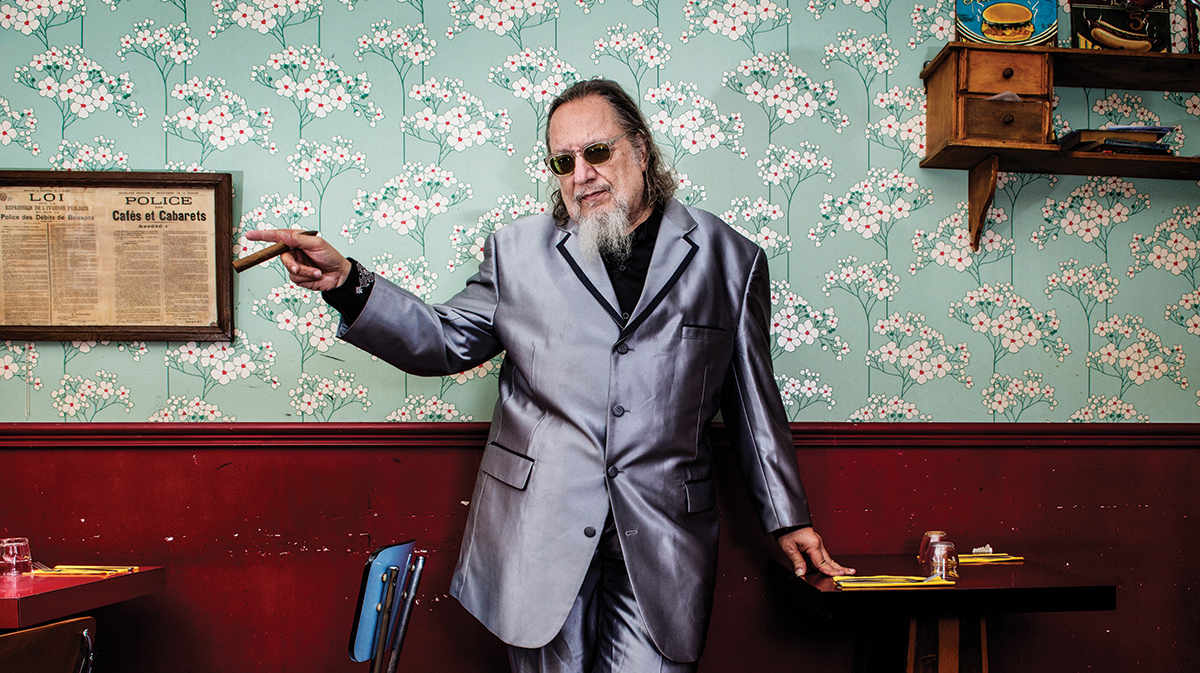
“Ratso” Gets His Due
Known as a colorful chronicler of counterculture figures, Larry Sloman MS’72 is finding his direction home as a singer-songwriter.
“It was four o’clock on a brandy-soaked October Thursday morning in Greenwich Village as about 20 friends and assorted hangers-on gathered in the shuttered-to-the-public Other End to hear Bob Dylan and his friends pick a few tunes.”
So goes the lede in Larry Sloman’s 1975 article for Rolling Stone, written just three years after he’d graduated from the UW with a master’s degree in sociology. Over the ensuing decades, Sloman has continued to chronicle counterculture milestones with uncommon panache as a reporter, ghostwriter, and all-around character. As seen in the Netflix documentary Rolling Thunder Revue: A Bob Dylan Story by Martin Scorsese, Sloman, embedded as a reporter on the singer-songwriter’s 1975 tour, earned the nickname “Ratso” from Joan Baez because he reminded her of Dustin Hoffman’s hustler in Midnight Cowboy.
After writing On the Road with Bob Dylan, Ratso went on to coauthor bestselling memoirs by Howard Stern and Mike Tyson. Distinguished by his six-inch goatee and raspy New York accent, Sloman occasionally works as an actor and has appeared in such movies as the 2019 indie thriller Uncut Gems. Last year, the Queens-born hipster released his debut album, Stubborn Heart, at the age of 70.
Looking back on his eclectic body of work, Sloman credits the UW as a formative influence. “Madison was a lot of fun,” he says. “I gravitated immediately toward criminology and deviance, which really informed what I do, because everything I’ve written about is to some extent filled with deviant subject matter.”
Supported by a full scholarship, Sloman showed up in Madison in August 1970, the day before Sterling Hall was blown up. “Coming from New York, you think you’re at the epicenter of the antiwar movement,” Sloman says. “But my first night in Madison, I heard this loud bang and thought it must be a car backfiring. I wake up in the morning and see the paper: the Army Math Research Center had been bombed. That was my introduction to Madison.”
A few days later, Sloman talked his way into becoming music editor for the Daily Cardinal. He interviewed a wide array of artists, including Liza Minnelli and Merle Haggard.
In late 1972, he and jazz musician Ben Sidran ’67 launched the late-night show The Weekend Starts Now on Madison’s NBC affiliate. The live broadcast featured C-grade horror movies and weekly “sermonettes” delivered at three in the morning by “the Reverend L. J. Sloman.”
“I wore a straw hat and a clerical collar over a Hawaiian shirt,” Sloman says, laughing. “I’d sell condos in the Holy Land, crazy stuff like that.”

Left to right: Playwright-actor Sam Shepard, Larry Sloman, Bob Dylan, and cinematographer David Myers confer in 1975 on the Rolling Thunder Revue tour, during which they were filming the movie Renaldo and Clara. Ken Regan
After earning his master’s, Sloman moved back to New York, where he shared an apartment with folksinger Phil Ochs while filing freelance articles for Rolling Stone. One afternoon in 1974, he spotted Bob Dylan behind the wheel of a car parked in front of an Elizabeth Arden hair salon. “I go over to him and say, ‘Hi Bob, my name’s Larry, and I’m a writer for Rolling Stone.’ Immediately, Dylan’s wary, throwing me this attitude, so then I said, ‘By the way, I’m Phil Ochs’s roommate.’ And Dylan just melts.”
Dylan warmed to Sloman’s subsequent review of Blood on the Tracks. One year later, Sloman showed up at an after-hours jam session in Greenwich Village where Dylan and his entourage were testing out songs for the impending Rolling Thunder Revue tour.
"Madison was a lot of fun...I gravitated toward criminology and deviance."
As dawn approached, Sloman recalls, “We all got into this cherry-red Cadillac 1973 convertible. Besides the fact that he had numerous drinks, Bob is not a very good driver to begin with, so we’re swerving all over the Village. We wind up at the Kettle of Fish [bar], and Bob says to me, ‘Why don’t you cover the tour? I’d rather have you do it than anybody else.’ ”
Describing his rapport with the famously press-shy Dylan, Sloman says, “I think one of the reasons Bob appreciated me is that I had that New York swagger, that New York attitude. On the tour, I’d tell him, ‘Come on man, you’re just a Midwest Jew. You’re not a real New York Jew like me.’ And he loved it!”
Following the publication of his Dylan book, Sloman penned a history of marijuana culture called Reefer Madness, then cracked open a new chapter of his career by ghostwriting Howard Stern’s 1993 memoir, Private Parts, and its sequel, Miss America.
“Here’s a guy who’s so brash and confident behind the mic, and such a brilliant interviewer, yet he was really insecure and had a lot of issues,” Sloman says. “We included a lot of personal stuff in the second book, like his obsessive-compulsive disorder. Howard is just as much a neurotic Jewish workaholic as I am. And he deserves every ounce of success he’s achieved.”
Sloman went on to write a Harry Houdini biography before embarking on an especially memorable collaboration with boxer Mike Tyson that yielded the 2013 bestseller Undisputed Truth.

Sloman (left) poses with Emily Jillette, boxer Mike Tyson, and magician Penn Jillette. Sloman collaborated on an autobiography and a memoir with Tyson. COURTESY OF LARRY SLOMAN
“He had such a great story, from rags to riches to rags again,” says Sloman. “When Mike was in prison, I mailed him a copy of Nietzsche’s autobiography Ecce Homo.” Years later, Sloman flew to LA and pitched his ghostwriting skills to Tyson, now out of prison. “The meeting’s over, I’m halfway out the door, and Mike calls out, ‘Ratso, did you send me that Nietzsche book because you thought I was Superman?’ I said, ‘No Mike, I sent you Ecce Homo because it helped me through some tough times, and I thought it might help you.’ And he goes, ‘Thank you, Ratso!’ That’s when we bonded.”
After spending most of his career telling other people’s stories, Sloman found his own voice as an artist a couple of years ago when he started writing songs with Brooklyn musician Vin Cacchione and singing them in the studio.
After spending most of his career telling other people's stories, Sloman found his own voice as an artist.
“My idea was to do a tribute album to myself, featuring my famous friends. Never in a million years did I think that I would be the vehicle for these songs.”
Sloman changed his mind after he brought the demo to his friend Hal Willner, whose producing credits include Lou Reed, Tom Waits, and Lenny Bruce.
“I go to Hal’s studio and say: ‘Tell me if I should be singing this song?’ I play it for him. Hal lies back, eyes closed. Song’s over, he opens his eyes, leans forward, and goes, ‘What are you waiting for?’ I took that as a yes.”

Sloman’s career has spanned reporting, ghostwriting, and acting. In 2019, the Queens-born hipster released his debut album at the age of 70. William Beaucardet
This year, Sloman has played his singer-songwriter role to the hilt while promoting Stubborn Heart. He performed on the Outlaw Country Cruise in the Bahamas alongside Kris Kristofferson and Lucinda Williams. There’s more to come, if Sloman has his way.
“It’s not like I’m going to be Adele or anything,” he muses. “But if I can just keep putting out albums and having fun, I’d love to keep doing it.”
Los Angeles writer-musician Hugh Hart ’72 has reported on movies and TV for Fortune magazine, the Los Angeles Times, and Wired.
Published in the Fall 2020 issue



Comments
No comments posted yet.